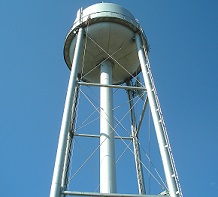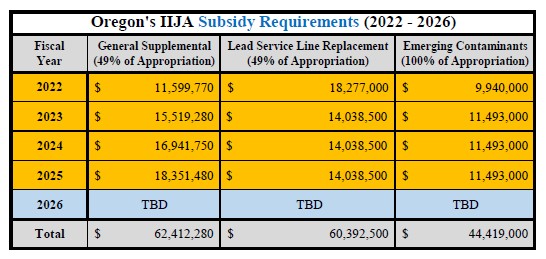
On November 15, 2021, the
Infrastructure Investment and Jobs Act (H.R. 3684), was signed into law. IIJA is a federally funded infrastructure package covering multiple critical infrastructure sectors throughout the U.S., including drinking water. The law provides the US Environmental Protection Agency (EPA) with grant funds that can be appropriated to states for investments in drinking water infrastructure over the next five years (2022 – 2026).
IIJA funding will be available to communities through the state’s existing Drinking Water State Revolving Fund (DWSRF), implemented jointly by Business Oregon and OHA Drinking Water Services. IIJA authorizes increases to Oregon’s existing base DWSRF program and includes appropriations for Supplemental DWSRF funding for infrastructure improvements, funding for identifying and replacing lead service lines and gooseneck connectors, and funding to address emerging contaminants (e.g., PFAS or other unregulated contaminants).
A key priority of IIJA is to ensure that disadvantaged communities benefit equitably, therefore, federal funding requirements stipulate that a significant portion of funds be provided in the form of loan subsidy.
Funding Availability


Funding Opportunities
IIJA General Supplemental:
IIJA authorizes increases to Oregon's existing base DWSRF program with supplemental appropriations for infrastructure improvements. With this funding, 49% of annual state appropriations must be in the form of additional subsidy (i.e., principal forgiveness) targeting disadvantaged communities.
Project and entity eligibilities for IIJA General Supplemental are the same as the base DWSRF program.
Visit the Intended Use Plan (IUP) web page to view the current IIJA General Supplemental IUP.
IIJA Emerging Contaminants (IIJA-EC):
IIJA authorizes increased funding to address emerging contaminants (e.g., PFAS or other unregulated contaminants). With this funding, 100% of annual state appropriations must be in the form of additional subsidy (i.e., principal forgiveness) with at least 25% of the funds going towards disadvantaged communities or public water systems serving fewer than 25,000 people.
For a project to be considered under the IIJA-EC funding, the purpose of the project must be to address and/or mitigate people's exposure to EC in drinking water, with priorities on perfluoroalkyl and polyfluoroalkyl substances (PFAS). Eligible project activities or components must be DWSRF eligible and identified in the funding application as integral to addressing the emerging contaminant of concern. Projects that address and/or mitigate EC that are listed on any of EPA's
Contaminant Candidate Lists (CCL1 - CCL5) are recognized as eligible.
Visit the Intended Use Plan (IUP) web page to view the current IIJA Emerging Contaminants IUP.
In addition to the IIJA-EC funding program, the new Emerging Contaminants in Small or Disadvantaged Communities (EC-SDC) grant program will provide states and territories with grants to public water systems in small or disadvantaged communities to address emerging contaminants. For more information visit EPA's EC-SDC website.
IIJA Lead Service Line Replacements (IIJA-LSLR):
IIJA authorizes increased funding for identifying and replacing lead service lines and connectors. Under this federal funding program, 49% of the funding the state receives must be provided in the form of forgivable loans allocated to Disadvantaged communities. This means a portion of the loan is forgiven and will not need to be repaid if the community meets the state’s definition of disadvantaged.
- For a project to be considered for funding, it must be directly connected to the identification, planning, design, or replacement of lead service lines. Projects must fully replace both the public and private side up to the point of premise plumbing.
- For a list of activities which are considered eligible or ineligible, please refer to the IIJA-Lead Service Line Replacement Funding Eligibilities Handout.
- Water systems that are interested in obtaining a loan (with potential forgivable loan) for future LSL inventory work (past the October 2024 date) are encouraged to submit a no-obligation Letter of Interest; see "How to Apply" below.
- For questions about this funding opportunity, contact Amy Bleekman, OHA Drinking Water Services, at 541-751-3154 or by email at amy.bleekman2@oha.oregon.gov.
How to Apply
-
Project and Entity Eligibilities for IIJA funded projects are the same as the base DWSRF program. For eligibility details, visit OHA's DWSRF web page, Business Oregon's SDWRLF web page, or EPA DWSRF Eligibility Handbook, all of which are applicable to eligible applicants and project types.
- IIJA-General Supplemental Funding: Eligible systems can submit a Safe Drinking Water Revolving Loan Fund Letter of Interest form anytime. Beginning in 2025, projects will be reviewed, rated, and ranked annually after the February 15 submission deadline.
- IIJA-Emerging Contaminants Funding: Eligible systems can submit an IIJA-Emerging Contaminant Funding Interest Form at any time. Beginning in 2025, projects will be reviewed, rated, and ranked annually after the February 15 submission deadline.
- IIJA-Lead Service Line Replacement Funding: Eligible systems can submit a Safe Drinking Water Revolving Loan Fund Letter of Interest form at any time. Beginning in 2025, projects will be reviewed, rated, and
ranked annually after the February 15 submission deadline.
- For help, please locate your Regional Development Officer for your area.
Project Priority Lists
The Project Priority Lists (PPL) for each of the three IIJA funding programs will be located on the
Project Priority Lists and Public Notices web page. A PPL is a list of proposed drinking water projects submitted by an eligible public water system that has been reviewed, rated, and ranked against strict public health criteria. Oregon’s DWSRF program rating and ranking criteria prioritizes projects that address risks to human health, compliance to the Safe Drinking Water Act, and is affordable to the applicant. The PPL is a major component of each grant application’s Intended Use Plan (IUP).
Intended Use Plans
The Intended Use Plans (IUP) for each of the three IIJA funding programs will be located on the Intended Use Plan (IUP) web page. An IUP describes how Oregon intends to use these funds and is the primary narrative for each grant application. The IUP is a federal grant requirement as part of each state’s grant application.
Resources
Contacts
- Business Oregon’s
Regional Development Officers can assist eligible public water systems with the best funding options in their area.
- Adam DeSemple, OHA’s Drinking Water State Revolving Fund Program Coordinator, at 503-956-8287 or by email at
adam.desemple@oha.oregon.gov.
- Tabitha Donaghue, OHA's Drinking Water State Revolving Fund Program Coordinator, at 503-730-7055 or by email at tabitha.donaghue@oha.oregon.gov.
- Nicole Bailey, Business Oregon’s Safe Drinking Water Program and Policy Coordinator, at 971-719-6862 or by email at
nicole.bailey@biz.oregon.gov.
- Kristen Larson, Business Oregon's Water Funding Coordinator, at 971-375-7511 or by email at kristen.larson@biz.oregon.gov.
- Gregg Baird, OHA's Emerging Contaminant Specialist, at 503-936-1657 or by email at
gregg.c.baird@oha.oregon.gov.
- Debra Lambeth, OHA’s DWSRF Environmental Review Coordinator at 503-936-7277 or by email at debra.g.lambeth@oha.oregon.gov.
- Amy Bleekman, OHA Drinking Water Services – Natural Resource Specialist, at 541-751-3154 or by email at amy.bleekman2@oha.oregon.gov.